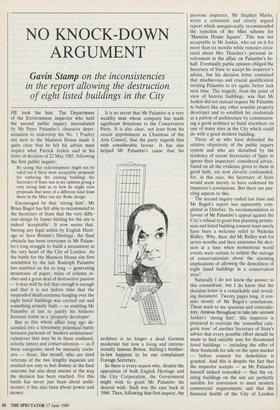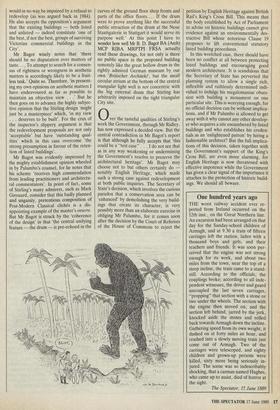NO KNOCK-DOWN ARGUMENT
Gavin Stamp on the inconsistencies
in the report allowing the destruction of eight listed buildings in the City
HE took the hint. The Department of the Environment inspector who held the second public inquiry necessitated by Mr Peter Palumbo's obsessive deter- mination to redevelop the No. 1 Poultry site next to the Mansion House made it quite clear that he felt his advice must respect what Patrick Jenkin said in his letter of decision of 22 May 1985, following the first public inquiry:
By saying that redevelopment might not be ruled out if there were acceptable proposals for replacing the existing buildings the Secretary of State was in my opinion giving' a very strong hint as to how he might view proposals that were of a different kind from those in the Mies van der Rohe design.
Encouraged by that 'strong hint', Mr Brian Bagot has felt able to recommend to the Secretary of State that the very diffe- rent design by James Stirling for the site is indeed 'acceptable'. It now seems that, barring any legal action by English Herit- age or Save Britain's Heritage, the final obstacle has been overcome in Mr Palum- bo's long struggle to build a monument in the very heart of the City of London. As the battle for the Mansion House site first assembled by the late Rudolph Palumbo has rumbled on for so long — generating mountains of paper, miles of column in- ches and a great deal of destructive passion — it may well be felt that enough is enough and that it is not before time that the suspended death sentence hanging over the eight listed buildings was carried out and something actually built — so enabling Mr Palumbo at last to justify his hitherto fictional status as a 'property developer'.
But as this whole affair long ago de- scended into a tiresomely polemical battle between partisans of 'modern architecture' (whatever that may be in these confused, eclectic times) and conservationists — as if these categories need be mutually exclu- sive — those, like myself, who are tired veterans of the two lengthy inquiries are entitled not only to feel dismay at the final outcome but also deep unease at the way the decision has been reached. For this battle has never just been about archi- tecture; it has also been about power and money. It is no secret that Mr Palumbo is a very wealthy man whose company has made significant donations to the Conservative Party. It is also clear, not least from his recent appointment as Chairman of the Arts Council, that the party regards him with considerable favour. It has also helped Mr Palumbo's cause that his architect is no longer a dead German modernist but now a living and interna- tionally famous Briton. Stirling's brother- in-law happens to be our complaisant Foreign Secretary.
So there is every reason why, despite the opposition of both English Heritage and the City Corporation, the Government might wish to grant Mr Palumbo his dearest wish. Such was the case back in 1984. Then, following that first inquiry, the previous inspector, Mr Stephen Marks, wrote a consistent and closely argued report which unequivocally recommended the rejection of the Mies scheme for 'Mansion House Square'. This was not acceptable to Mr Jenkin, who sat on it for more than six months while rumours circu- lated about Mrs Thatcher's personal in- volvement in the affair on Palumbo's be- half. Eventually public opinion obliged the Secretary of State to accept his inspector's advice, but his decision letter contained that mischievous and crucial qualification inviting Palumbo to try again: better luck next time. The tragedy, from the point of view of historic buildings, was that Mr Jenkin did not instead require Mr Palumbo to behave like any other sensible property developer and to establish his credentials as a patron of architecture by commission- ing a good architect to build elsewhere on one of many sites in the City which could do with a good modern building.
Those of us who have defended the relative objectivity of the public inquiry system and who are disturbed by the tendency of recent Secretaries of Sjate to ignore their inspectors' considered advice, based on all the evidence given to them in good faith, are now cleverly confounded, for, in this case, the Secretary of State would seem merely to have endorsed his inspector's conclusions. But there are puz- zling aspects to this.
The second inquiry ended last June and Mr Bagot's report was apparently com- pleted in October. Its recommendation in favour of Mr Palumbo's appeal against the City's refusal to grant him planning permis- sion and listed building consent must surely have been a welcome relief to Nicholas Ridley. Why, then, did Mr Ridley wait for seven months and then announce his deci- sion at a time when momentous world events were certain to eclipse the outrage of conservationists about the alarming implications of allowing the demolition of eight listed buildings in a conservation area?
Naturally I do not know the answer to this conundrum, but I do know that the decision letter is a remarkable and reveal- ing document. Twenty pages long, it con- sists mostly of Mr Bagot's conclusions. These seem to me specious and contradic- tory. Anxious throughout to take into account Jenkin's 'strong hint', this inspector is prepared to overrule the 'somewhat cate- goric tone' of another Secretary of State's advice that every possible effort should be made to find suitable uses for threatened listed buildings — including the offer of their freeholds for sale on the open market — before consent for demolition is granted. And this is despite the fact that the inspector accepts — as Mr Palumbo himself indeed conceded — that the ex- isting buildings on the site are perfectly suitable for conversion to meet modern commercial requirements and that the financial health of the City of London would in no way be impaired by a refusal to redevelop (as was argued back in 1984). He also accepts the opposition's argument that the existing buildings — both listed and unlisted — indeed constitute 'one of the best, if not the best, groups of surviving Victorian commercial buildings in the City'.
Mr Bagot wisely notes that 'there should be no disputation over matters of taste.... To attempt to search for a consen- sus of rightness or wrongness in aesthetic matters is accordingly likely to be a fruit- less task.' Quite so. Therefore, 'in present- ing my own opinions on aesthetic matters I have endeavoured as far as possible to maintain an objective view . . .' But he then goes on to advance the highly subjec- tive opinion that the Stirling design 'might just be a masterpiece' which, 'in my view . . . deserves to be built'. For the crux of the inspector's slippery argument is that the redevelopment proposals are not only 'acceptable' but have 'outstanding qual- ities' which in this case overcome 'the strong presumption in favour of the reten- tion of listed buildings'.
Mr Bagot was evidently impressed by the mighty establishment opinion wheeled in by Palumbo's counsel, for he notes that his scheme 'receives high commendation from leading practitioners and architectu- ral commentators'. In point of fact, some of Stirling's many admirers, such as Mark Girouard, consider that this badly planned and ungainly, pretentious composition of Post-Modern Classical clichés is a dis- appointing example of the master's oeuvre. But Mr Bagot is struck by the 'coherence of the design' in that 'the central unifying feature — the drum — is pre-echoed in the curves of the ground floor shop fronts and parts of the office floors.... If the drum were to prove anything like the successful public attraction of the drum at the Neue Staatsgalerie in Stuttgart it would serve its purpose well.' At this point I have to wonder how well Mr B. D. Bagot BA (Arch) MCP RIBA MRPTPI FRSA actually read these drawings, for not only is there no public space in the proposed building remotely like the great hollow drum in the rightly admired German museum by our own 'Britischer Architeke , but the small circular atrium at the bottom of the central triangular light well is not concentric with the big external drum that Stirling has arbitrarily imposed on the tight triangular City site.
0 ver the tasteful qualities of Stirling's work the Government, through Mr Ridley, has now expressed a decided view. But the central contradiction in Mr Bagot's report is that although he fully accepts that 'this could be a "test case" . . . I do not see that as in any way weakening or undermining the Government's resolve to preserve the architectural heritage'. Mr Bagot may choose not to but others certainly do notably English Heritage, which made such a strong case against redevelopment at both public inquiries. The Secretary of State's decision, which involves the curious paradox that a conservation area can be 'enhanced' by demolishing the very build- ings that create its character, is very possibly more than an elaborate exercise in obliging Mr Palumbo, for it comes soon after the decision by the Court of Referees of the House of Commons to reject the
petition by English Heritage against British Rail's King's Cross Bill. This means that the body established by Act of Parliament to advise on historic buildings cannot give evidence against an environmentally des- tructive Bill whose notorious Clause 19 proposes to lift conventional statutory listed building procedures.
In this wretched case, there should have been no conflict at all between protecting listed buildings and encouraging good modern architecture. It is scandalous that the Secretary of State has perverted the planning system to allow a single rich, inflexible and ruthlessly determined indi- vidual to indulge his megalomaniac obses- sion with building a monument on one particular site. This is worrying enough, for no official decision can be without implica- tions, and if Mr Palumbo is allowed to get away with it why cannot any other develop- er who acquires a site encumbered by listed buildings and who establishes his creden- tials as an 'enlightened patron' by hiring a fashionable architect? But the full implica- tions of this decision, taken together with the Government's support of the King's Cross Bill, are even more alarming, for English Heritage is now threatened with effective impotence while the Government has given a clear signal of the importance it attaches to the protection of historic build- ings. We should all beware.



















































 Previous page
Previous page